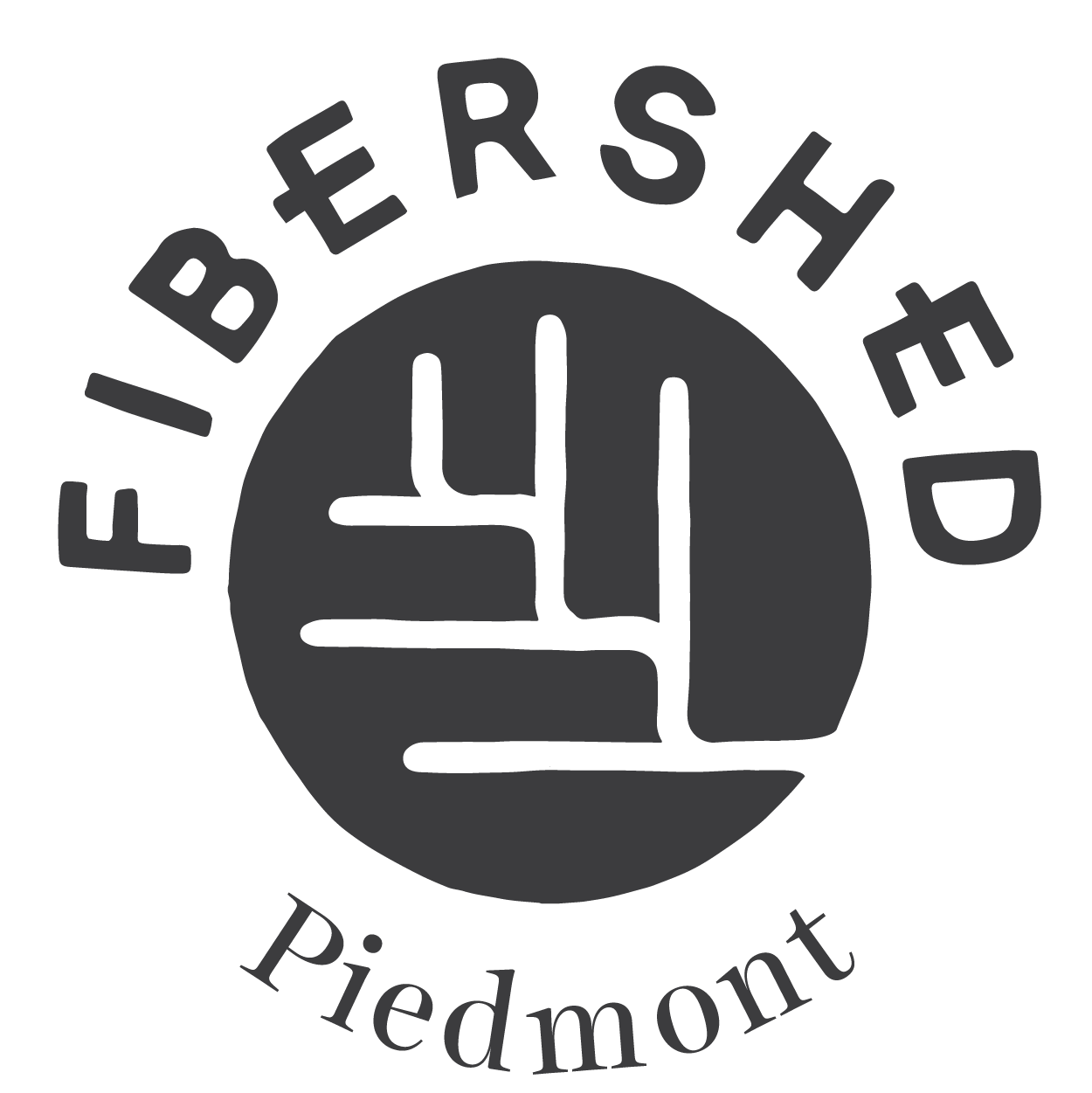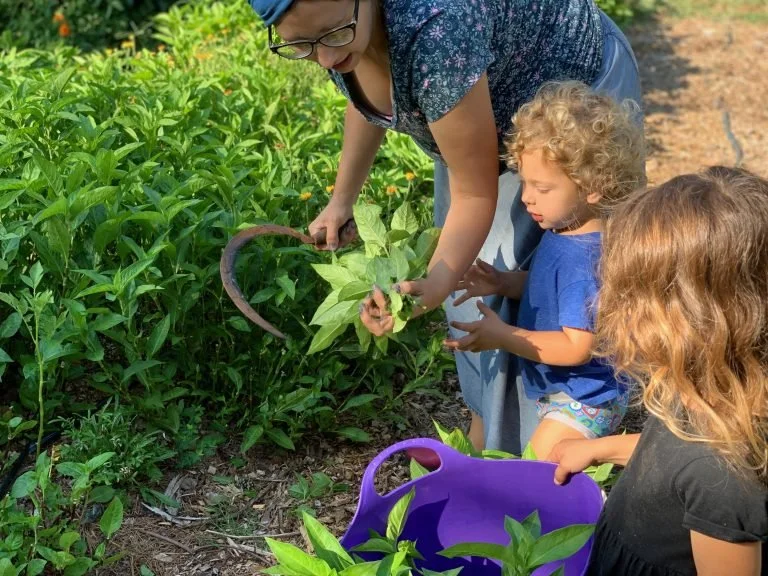Growing a Carolina Piedmont Dye Garden
Growing a Carolina Piedmont Dye Garden – Interview with Bethany Hebbard
Written by Sage Shelton, member of Piedmont Fibershed
Bethany has led workshops for Piedmont Fibershed on Natural Dyeing. Join us for “Growing a Carolina Piedmont Dye Garden” in-person on April 5th from 9am-5pm. Register here.
Bethany, a member of Piedmont Fibershed, first got interested in natural dyes back in her college days. While studying literature, she became fascinated by references to textiles in fairy tales. Though many aspects of fiber arts interested her, she made the decision to try natural dyeing because of her ability to be outside and create a kid-friendly environment where her kids could take part in the fun. Her husband is a permaculture-trained farmer and has been very supportive of her interest in dyeing with plants.
Bethany in her garden (Photo Credit Bethany Hebbard)
Bethany has been planting dye gardens for nine years. At the time she started her dye garden, she was living in Austin, TX and was able to access space via a community garden. She was able to connect with locals to learn from their research and use their seeds. One resource that was particularly helpful for her in getting started was Deb McClintock’s blog. She’s also found some niche online groups, such as the Facebook Group “Indigo Pigment Extraction Methods” to be engaging. Around the time she started her first dye garden, Bethany read “Harvesting Color” by Rebecca Burgess and began to learn more about the Fibershed movement. Bethany also loves “Women’s Work: The First 20,000 Years” by Elizabeth Wayland Barber because it reminds her that textile traditions and raising a family can go hand-in-hand.
I sat down with Bethany to chat about her experience with natural dyes.
Sage: Can you walk me through the process of planting a dye garden for the first time?
Bethany: We like to use a primarily no-till approach. To establish a bed for the first time, you could follow what we did here when we moved. What we did in our garden is a technique sometimes called “lasagna gardening”. First, we put a tarp down to kill any weeds in the area that we wanted our garden to be and let the start sit for a few weeks. Then we laid down layers of cardboard. That serves as a nice weed barrier. The cardboard will biodegrade after about a year or so. For our soil, we purchased a high quality loam-compost mix. The compost mix is great for helping plants start strong. You only have to do it once – you don’t need to put down new compost every year.
If you want to grow in pots, you can do that as well. Mix backyard dirt and high quality compost at a 50/50 blend.
Japanese Indigo in Bethany’s Garden (Photo Credit Bethany Hebbard)
From there, dye gardening is a “choose your own adventure” kind of project and you can plant what you like.
Sage: What are some of your favorite dye plants to grow?
Bethany: One of the plants I love to grow is Indigo, which are several species of plants that produce blue dye. In Texas, the variety that grew really well was Guatemalan Indigo. It loves the heat and isn’t put off by drought. It’s a legume. My Guatemalan Indigo hasn’t flourished in the Piedmont’s shorter and more mild summers. Japanese Indigo, on the other hand, loves it here. Japanese indigo is an annual and it’s in the buckwheat family.
Sage: How do you plant your Indigo?
Bethany: With my Japanese Indigo seeds, I start them indoors in late February or early March under a grow light. Last year, I had several volunteers crop up. So, I think this year I’m actually going to do more direct sowing outside. If you’re going to sow the seeds directly, it is common to wait until after the last frost. You might wait until late March. The best practice is to sow the seeds thickly and then thin them out after they have popped up, leaving about 10-12 inches of space between each plant. Japanese Indigo loves water, so be sure to place them in your garden somewhere they’ll be easy to water. We’ll usually water seedlings with sprinklers and they’re usually established by a few weeks. We’ve found our rainfall and humidity to be sufficient here.
If you’re growing them in pots, you don’t need to worry about them getting soggy. They like having wet feet. You can place a plate under your pot to make sure that they don’t dry out. The Japanese Indigo will grow and you’ll have nice seedlings coming up through April and May. Indigo is a plant you can harvest two or three times during the growing season. It starts to flower around the end of August and then those flowers turn to seeds. I always collect my seeds.
Sage: What are other plants you really enjoy?
Bethany: I also love madder, which is a perennial plant. The roots are used for dye. It’s important to be strategic about placing perennial plants because they’re harder to move. I grow my madder in pots. Their roots have a tendency to invade other plants. Be cautious of planting madder too close in the ground to other plants – it can make harvest really challenging. We’ll probably build a raised bed for our madder. We have an IBC tote cut in half, which we’re going to try making a planter out of. Another thing to remember is that madder takes about 3 years to establish before a first harvest. Since you’ll only be harvesting a plant every 3 years, it’s ideal to plant madder each year so the plants are in different parts of the cycle. You can easily start a new plant by taking cuttings from an existing plant in the fall.
Sage: What spacing is ideal for madder?
Bethany in the dye garden with her children (Photo Credit Bethany Hebbard)
Bethany: Spacing isn’t much of an issue. To be honest, I just let my madder grow in one big tangle and it’s always been really happy. If you want to plant madder in the ground and keep the root structures separate, using a spacing of two to three feet would be ideal.
Sage: Are there any other dye plants that you specially recommend for the North Carolina Piedmont region?
Bethany: Yeah, so in terms of what I cultivate in my garden, I usually grow sulfur cosmos, and I usually grow coreopsis. I primarily grow those because they’re fun to use with kids. And so we’ll often invite the kids from church over or something so that they can play with solar dyeing. Both of these self-sow very easily. They’re unfussy and easy to grow.
I’ve experimented a little bit with growing woad, which isn’t considered invasive in North Carolina but is considered invasive in some states further west. I was primarily interested in it because I figured all different cultures have plants that they have an ancestral relationship with. As a European, I figured I should probably get to know woad. It’s a brassica in the cabbage family. It grew really well here. The primary challenge was that it can easily be mistaken for wild mustard in the garden and be weeded out accidentally. It’s a biennial, meaning it stays in place for two years. I’ll likely continue to grow some for demonstration purposes.
I also love goldenrod. It seems kind of silly to cultivate goldenrod when we have so much of it everywhere. I once tried cultivating goldenrod from seed and the crop did not germinate well. I’ve since learned that root division is actually the best way. If your grandma has a ton of goldenrod in her backyard and you want to bring some home, then the best thing to do is just dig some up and plant it at your house.
And then there’s black walnut. Most people are a little leery of planting black walnut trees because of the mess. There was a mature black walnut tree at the house we bought. I don’t know if I would go out of my way to plant it again, because you can forage it so readily.
Sage: Are there any other plants that are helpful to have in the garden?
Bethany: I realized we were using a lot of soy milk in the dyeing process, especially for fresh leaf Indigo, and decided to start growing soybeans here. I’m from Indiana where soybeans take up half the state. It turns out they’re very easy to grow. Last year, I grew just one or two. I’ll probably grow some more this year, because that’s such a useful assist in various dye processes. Not only using it to treat cellulose fiber to make it more receptive to certain dyes but also for making soy paste. I believe using soy paste is a traditional Chinese method.
The most exciting plant on our property is Symplocos. The leaves of the Symplocos plant have alum, which can be used as a mordant. The plant pulls aluminum up from the soil and it bioaccumulates in the leaves. So as the dried leaves fall off, I’m collecting those and eventually I will have enough to try to use as a mordant. The plant is young, so obviously it’s not supplying much and it’s growing slowly. It was fun to add that to the garden. The common names for Symplocos are sweetleaf and horse sugar.
Sage: What do you wish you had known before starting your dye garden?
Bethany: I wish I had realized earlier how the garden liberates me to play with materials without really having to worry about scarcity. Because a garden is such a reminder of abundance. If you mess up, you can just do it again next year. The first time I grew indigo, I wouldn’t try anything with it until I had everything lined out and felt like the design was perfect. Now, I harvest huge armfuls of leaves because I’m going to grow more leaves back and I’m going to have more next year. And frankly, I have more leaves than I could possibly use. I don’t have to think “oh, this is such a waste of money if this project fails” or “this has to look good.” My goal is to be responsible with materials, while being okay with some things going back into the compost.
Sage: Now you’re more willing to experiment and see what happens?
Bethany: You know, all kids love to play with a messy pot that turns things different colors, right? I wanted something that I could not only do around them but also invite them to join me. To be able to say, “Hey, you want to hit this leaf with a hammer?” Getting to participate in the play myself in the garden is a really sweet thing in the garden.
Sage: It sounds like such a nice way to spend time with your family. Thanks for taking the time to chat today! Maybe you want to turn a hobby into something more. Or maybe you have a creative project to share with the world. Whatever it is, the way you tell your story online can make all the difference.
Don’t worry about sounding professional. Sound like you. There are over 1.5 billion websites out there, but your story is what’s going to separate this one from the rest. If you read the words back and don’t hear your own voice in your head, that’s a good sign you still have more work to do.
Be clear, be confident and don’t overthink it. The beauty of your story is that it’s going to continue to evolve and your site can evolve with it. Your goal should be to make it feel right for right now. Later will take care of itself. It always does.



